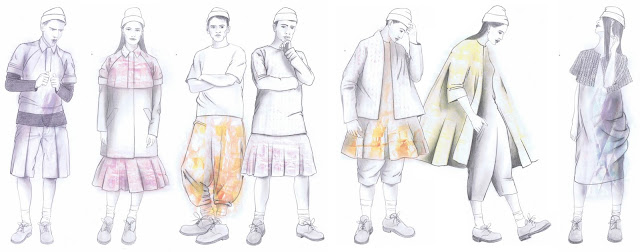Please introduce yourself to our readers. (Who are you, where do you come from and what is your field of specialization?)
My name is Joshua Enker, I am a fashion designer from Amsterdam. I design for both men and women and I tend to start from material development.
What inspires you in general?
Fashion, art, history, crafts...the idea of transformation and how one is perceived.
Where are you based?
I’m based in Amsterdam, for now.
What is it like to be a young designer in your city/country?
There’s a whole web of institutions, subsidies, etc. that seem to support fashion, however it’s quite daunting to find your way through it though. Selling and actually producing your work is a big challenge, as there is hardly a market for home-grown design. The Dutch will spend on their homes but not on clothing and accessories.
What place/city do you find inspiring?
That has to be London; it just has tons more energy than Amsterdam. I also really like New York. Tokyo and Sao Paolo are high on the top of my wish-list of places to go to.
What is the concept behind your latest collection/creation?
For this collection I started by looking at Agatha Christie’s character of Miss Marple, as part of a project I was to do with my partner, who unfortunately had to pull out due to too full a schedule. Actually, I don’t particularly like Agatha Christie or murder mysteries, so I read some of the books, I looked at films, and even though Miss Marple is a fictional character I found a biography on her, it took a while to find an angle.
There was the fact she was an elderly lady, which led me to consider how older people in our society are almost invisible. Often they are written off or placed in a pastel-colored innocuous category. Miss Marple is often described as fluffy and dithering, yet underneath beats an iron will and logic; she uses the fact that she is often underestimated to her advantage. Turning a supposed negative into a positive, that was my angle. This notion led to fabric development. I took an iridescent fabric, which some people would call cheap or gaudy, and manipulated it through pleating and various heat processes to transform and hopefully elevate it. The fluffy-outside-iron-logic-inside idea I translated in a wool embroidered metal mesh.
Describe your collection in three words.
Fuzzy, shiny and pleated
Did you always want to work in the field of fashion?
For as long as I can remember I have loved clothes and fashion. I was one of those kids that designed clothes for his Barbie dolls, be it under the disapproving eye of my mother.
Do you have a muse? If yes, who is it and why?
Susie Lau from Style Bubble; we seem to share a taste and enthusiasm for fashion. China Chow is quite inspiring and beautiful too.
Who is your favorite fashion designer?
There are so many: Comme des Garçons, Isobel Toledo, Geoffrey Beene, Alexandre Herchcovitch, Osklen, Louise Gray, Meadham Kirchoff, Christopher Kane, etc.
What is so far your greatest experience in your 'fashion' career?
Meeting people such as Lidewij Edelkoort and Vivienne Westwood was so great.
What is on your music list while you are making your collection/creation?
Actually I didn’t listen to too much music this time around, rather having BBC Radio 4 in the background. Tracks like ‘English Summer Rain’ by Placebo and ‘English Summer’ by Eurythmics suggested themselves quite quickly though.
What made you smile today?
Probably something silly a friend posted on Facebook.
What is the latest thing you bought for yourself?
Christopher Kane ‘Frankenstein’ T-shirt.
Did you meet any technical difficulties in applying your design concept to practical production?
Often you can be quite happy with fabric samples you have made, but once you start applying the same technique on a larger scale is when you can run into challenges. Pleating the fabric seemed to take forever and navigating how to get the fabric into the oven and the press was quite tricky.
How do you perceive the changes of fashion trends over time, when you looked at fashions from the 1930s through the 1960s?
The Miss Marple stories were first published in the 1930s, but Agatha Christie kept on with the character well up until the 1960s. That gave me a broad period to look at, then again Miss Marple was no fashion plate and furthermore I didn’t want to turn the collection into a costume piece. So there are just hints to those periods, a 1950s coat here, a 1930s dress there...However the fitted knee-length skirt suit seemed to be indispensable. A country classic such as the Norfolk tweed jacket was particularly inspiring for its pleat detail.
Do you often or occasionally get inspirations from books, magazines or other type of printed publications?
A life-long habit of mine is to read a lot of books and magazines on fashion. I peruse blogs and I spend a little too much time on Tumblr. The trick is to immerse oneself in the material and when it comes to designing one just has to let it go. Also I find it’s good to let yourself be surprised.
How was the first experience of having your own collections shown to public in FCM 2012 event?
2012 was the first time I participated in ‘FASHIONCLASH Maastricht’, and I found it to be a very encouraging experience. I showed an adapted version of my graduation collection. My graduation was a bit of disappointing experience, so showing this collection in a different environment was a real boon in positive way.
Credits
Drawing by Joshua Enker
Photographer: Peter Stigter
Pagina's
maandag 13 mei 2013
Joshua Enker Presents New Collection
Labels:
Agatha Christie,
Amsterdam,
art,
Barbie,
BBC Radio,
China Chow,
Christopher Kane,
Comme des Garçons,
crafts,
FASHIONCLASH Maastricht 2013,
London,
New York,
participants profile,
Susie Lau,
Tokyo,
Vivienne Westwood
Abonneren op:
Reacties posten (Atom)

.jpg)

.jpg)
.jpg)

Geen opmerkingen:
Een reactie posten